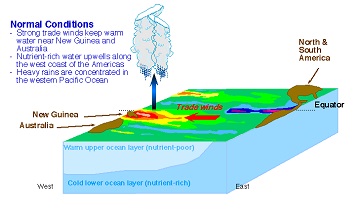371215-pac influence.jpg

Normally, "Trade Winds" blow strongly from east-to-west and "pile up" warm ocean water in the Western Pacific. Credit NASA
The rise in global temperatures isn’t smooth and even, like turning on a flame under a tea kettle. That’s because it’s a complicated process that involves the atmosphere, the oceans, and other factors.
One of those factors seems to be trade winds over the Pacific Ocean. Weaker winds lead to higher temperatures, while stronger winds tend to cool things down a bit.
Researchers found evidence of that while studying a period of intense warming -- from 1910 to 1940. The global temperature rose by about two-thirds of a degree, even though human-caused warming was a much smaller factor than it is now.
Records of Pacific winds during that period are spotty, so the researchers studied coral found on an island near the equator. By measuring the ratios of certain elements found in the coral, the researchers discovered that westerly winds were more common during that period.
Winds from that direction tend to be fairly weak, so they don’t stir up the top layers of water. The water basically sits in the sunlight and gets hotter and hotter -- warming the entire planet as it does so. The study period was followed by several decades of strong easterly winds, which cooled the upper layers of the Pacific and slowed the overall warming trend.
We’re in a similar pattern right now -- fairly strong winds blowing from east to west. That may have contributed to a slowdown in the warming pattern over the last few years. If that’s the case, then warming will intensify when the trade winds weaken once again.

